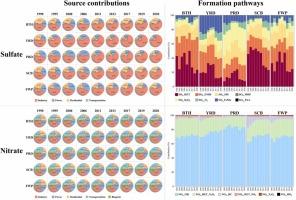中国 1990-2020 年硫酸盐和硝酸盐变化评估:洞察源贡献和形成途径
IF 11.3
1区 环境科学与生态学
Q1 ENGINEERING, ENVIRONMENTAL
引用次数: 0
摘要
硫酸盐(SO42-)和硝酸盐(NO3-)是细颗粒物(PM2.5)的两个关键成分,对空气质量和公众健康产生重大影响。本研究利用修订后的社区多尺度空气质量模拟系统(CMAQ),对1990 - 2020年中国SO42-和NO3-水平的时空变化进行了全面评估,重点阐明了污染源贡献和形成途径。结果表明,2017年以来,中国大部分地区NO3-污染日益严重,其浓度超过了SO42-。工业排放是影响SO42-水平的主要因素,京津冀地区占40.2%57.5%,长三角地区占51.0%76.6%,珠三角地区占46.8%68.2%,四川盆地占38.9%62.8%,汾渭平原占36.1%58.8%。对于NO3-,工业排放在北京(27.7%33.1%)和长三角(31.0%33.6%)占主导地位,而交通排放是珠江三角洲的主要排放源(26.4%36.3%),在SCB和FWP,这些部门的贡献相当。SO42-的形成途径具有明显的区域差异:总体而言,BTH(23.7%47.3%)和YRD(24.1%30.5%)以一次排放SO42-为主,SCB(23.2%55.5%)和FWP(20.5%48.9%)以多相反应为主,PRD(23.6%32.8%)以H2O2水相氧化SO2为主。相比之下,NO3-的生成途径在所有地区都表现出一致性,NO2被OH气相氧化反应和N2O5的非均相反应占其生成的90%以上。这项研究强调了有针对性的空气质量管理策略的必要性,这些策略应考虑污染源贡献的区域差异,并优先考虑减少驱动二次气溶胶形成的关键氧化剂。这些发现可以为制定有效措施以减轻空气污染的政策制定者提供有价值的见解。本文章由计算机程序翻译,如有差异,请以英文原文为准。

Assessment of sulfate and nitrate variations in China during 19902020: Insights into source contributions and formation pathways
Sulfate (SO42-) and nitrate (NO3-) are two critical constituents of fine particulate matter (PM2.5), significantly impacting air quality and public health. This study provides a comprehensive assessment of spatial and temporal variations in SO42- and NO3- levels across China from 1990 to 2020 by using a revised Community Multiscale Air Quality Modeling System (CMAQ), focusing on elucidating insights into source contributions and formation pathways. The results reveal that NO3- pollution has become increasingly significant, with its concentrations surpassing those of SO42- in most regions of China since 2017. Industrial emissions were identified as the primary contributors to SO42- levels, accounting for 40.2 %![]() 57.5 % in Beijing–Tianjin–Hebei region (BTH), 51.0 %
57.5 % in Beijing–Tianjin–Hebei region (BTH), 51.0 %![]() 76.6 % in Yangtze River Delta (YRD), 46.8 %
76.6 % in Yangtze River Delta (YRD), 46.8 %![]() 68.2 % in Pearl River Delta (PRD), 38.9 %
68.2 % in Pearl River Delta (PRD), 38.9 %![]() 62.8 % in Sichuan Basin (SCB), and 36.1 %
62.8 % in Sichuan Basin (SCB), and 36.1 %![]() 58.8 % in Fenwei Plain (FWP). For NO3-, industrial emissions were predominant in BTH (27.7 %
58.8 % in Fenwei Plain (FWP). For NO3-, industrial emissions were predominant in BTH (27.7 %![]() 33.1 %) and YRD (31.0 %
33.1 %) and YRD (31.0 %![]() 33.6 %), while transportation emissions were the major source in PRD (26.4 %
33.6 %), while transportation emissions were the major source in PRD (26.4 %![]() 36.3 %), in SCB and FWP, contributions from these sectors were comparable. The formation pathways of SO42- exhibited distinct regional variations: overall, primary emission of SO42- was the predominant pathway in BTH (23.7 %
36.3 %), in SCB and FWP, contributions from these sectors were comparable. The formation pathways of SO42- exhibited distinct regional variations: overall, primary emission of SO42- was the predominant pathway in BTH (23.7 %![]() 47.3 %) and YRD (24.1 %
47.3 %) and YRD (24.1 %![]() 30.5 %), heterogeneous reaction dominated in SCB (23.2 %
30.5 %), heterogeneous reaction dominated in SCB (23.2 %![]() 55.5 %) and FWP (20.5 %
55.5 %) and FWP (20.5 %![]() 48.9 %), and aqueous-phase oxidation reaction of SO2 by H2O2 was the leading formation pathway in PRD (23.6 %
48.9 %), and aqueous-phase oxidation reaction of SO2 by H2O2 was the leading formation pathway in PRD (23.6 %![]() 32.8 %). In contrast, the formation pathways of NO3- demonstrated consistency across all regions, with combined gas-phase oxidation reaction of NO2 by OH and the heterogeneous reaction of N2O5 accounting for over 90 % of its production. This study highlights the need for targeted air quality management strategies that account for regional variations in source contributions and prioritize the reduction of key oxidants driving secondary aerosol formation. The findings could offer valuable insights for policymakers developing effective measures to mitigate air pollution.
32.8 %). In contrast, the formation pathways of NO3- demonstrated consistency across all regions, with combined gas-phase oxidation reaction of NO2 by OH and the heterogeneous reaction of N2O5 accounting for over 90 % of its production. This study highlights the need for targeted air quality management strategies that account for regional variations in source contributions and prioritize the reduction of key oxidants driving secondary aerosol formation. The findings could offer valuable insights for policymakers developing effective measures to mitigate air pollution.
求助全文
通过发布文献求助,成功后即可免费获取论文全文。
去求助
来源期刊

Journal of Hazardous Materials
工程技术-工程:环境
CiteScore
25.40
自引率
5.90%
发文量
3059
审稿时长
58 days
期刊介绍:
The Journal of Hazardous Materials serves as a global platform for promoting cutting-edge research in the field of Environmental Science and Engineering. Our publication features a wide range of articles, including full-length research papers, review articles, and perspectives, with the aim of enhancing our understanding of the dangers and risks associated with various materials concerning public health and the environment. It is important to note that the term "environmental contaminants" refers specifically to substances that pose hazardous effects through contamination, while excluding those that do not have such impacts on the environment or human health. Moreover, we emphasize the distinction between wastes and hazardous materials in order to provide further clarity on the scope of the journal. We have a keen interest in exploring specific compounds and microbial agents that have adverse effects on the environment.
 求助内容:
求助内容: 应助结果提醒方式:
应助结果提醒方式:


